 |
WATERCRESS AND GRUYERE SCONES
100g (4oz) Self-Raising flour
100g (4oz) Wholemeal Self-Raising flour
100g (4oz) butter cut into cubes
50g (2oz) gruyere cheese, grated
85g (3 1/4oz) watercress, thick stems removed and leaves chopped small but not to a pulp
1 teaspoon wholegrain mustard
4- 5 tablespoons milk
1 egg, beaten
- Oil a baking sheet and leave on one side
- Pre-heat oven to 200c (Gas 7)
- Sift flours into a medium sized bowl
- Rub in the butter cubes until mixture looks like breadcrumbs
- Stir in grated cheese, watercress and mustard
- Make a well in centre of mixture and add milk (enough to make a soft dough)
- On a floured board roll out dough to 2.5cm (1 “) thick, then with 5cm (2”) pastry cutter,
cut out scones. Mixture makes 8 scones.
Brush tops of scones with beaten egg to glaze Bake in the hot oven for 15 minutes and serve warm cut in half with butter. I like to serve these with lentil soup for a hearty supper meal. |
|
FEBRUARY 2016
Oranges and almonds from Spain and Sicily - sunnier climates than England in February -inspired me to create this cheerful fresh-tasting easily made cake.
Cake
4 oz (100 g) butter
6oz (175g) caster sugar
6oz (175g) self-raising flour
2 large eggs
Pinch of salt
¼ pint (450ml; 15 fl oz) milk
1 teaspoon almond essence
Zest from 1 orange (skin well washed first)
Pre-warm oven to 180 C (350F), then in one bowl mix the above ingredients together with an electric mixer or wooden spoon until smooth. Line a 2lb (1kg) loaf tin with buttered greaseproof paper or shaped cake tin liner and transfer the mixture into the tin. Cook for 1 hour.
TOPPING
While the cake is cooking prepare the topping using the following ingredients:
1 oz (25g) almonds, toasted in warm oven until golden brown. Leave on one side.
10 minutes before the cake has finished cooking, prepare the topping:
1 tablespoon of caster sugar
1 tablespoon on ground almonds
1 tablespoon of butter
Zest from 1 orange, juice from the two oranges
Place the sugar, ground almonds, butter and orange zest in a small saucepan and cook together over a gentle heat, stirring continuously with wooden spoon to prevent it burning, until the mixture bubbles and goes golden brown. Then little by little add the orange juice and blend into the mixture. Remove from heat.
When the cake is cooked, remove from oven and transfer to a heat proof board. Do not remove from the tin yet. While cake is still warm, pour half the topping from saucepan over the cake, then decorate with the toasted almonds which will stick onto the topping, then pour the rest of the topping mixture over the surface of the cake. When cake is cool remove from tin.
|
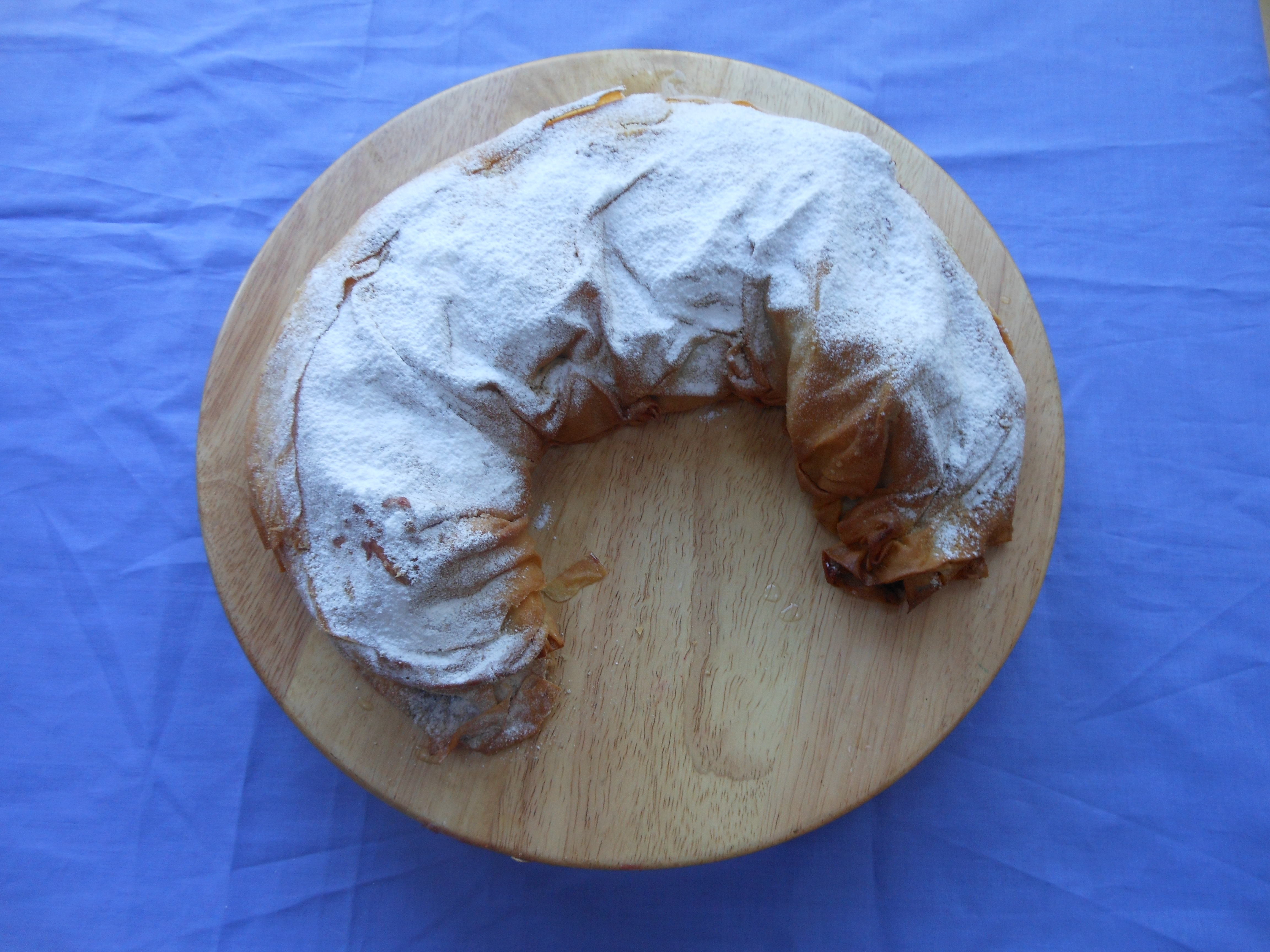
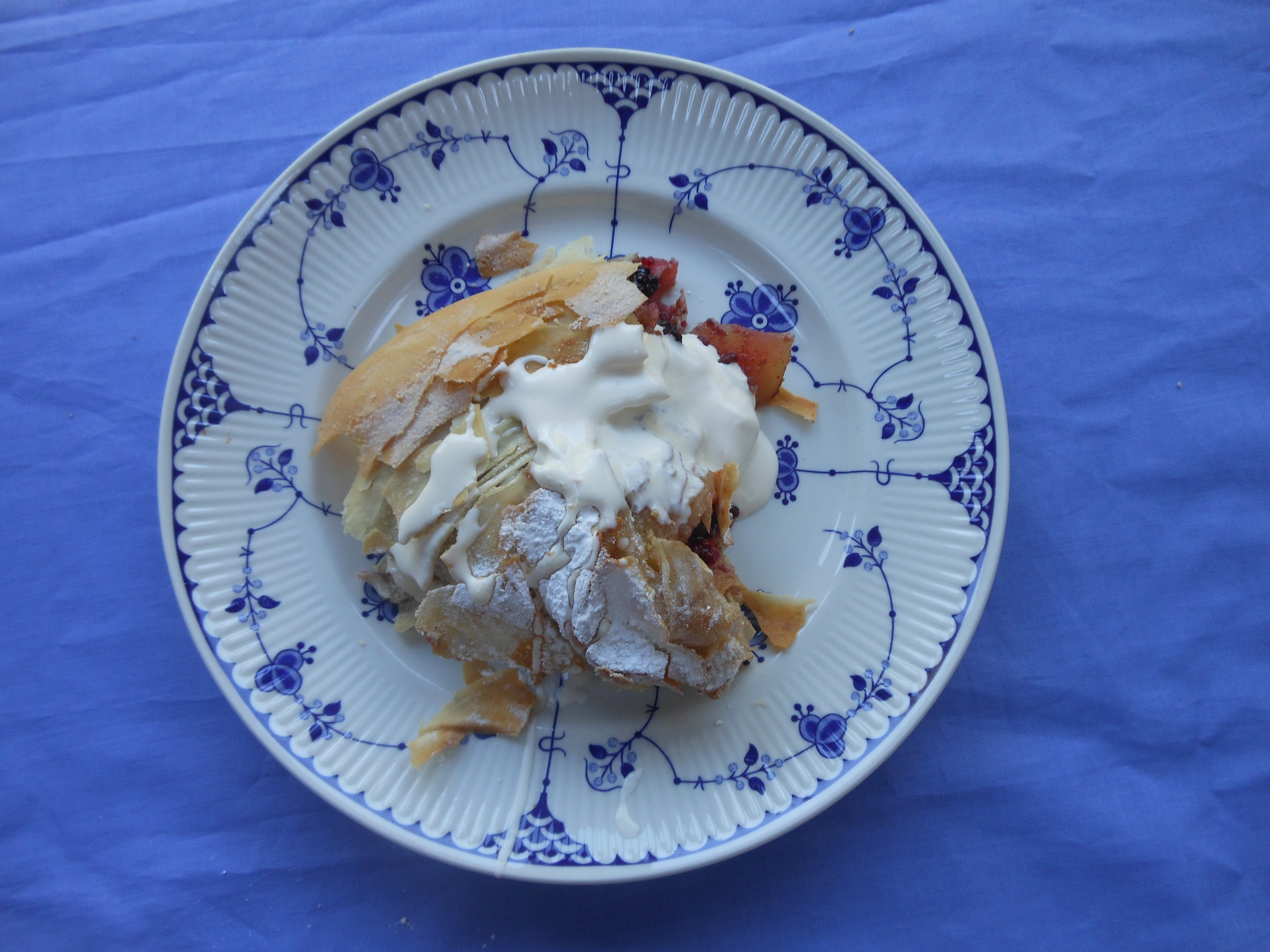
|
OCTOBER 2013
Blackberry and Apple Strudel
4 Filo pastry sheets from 1 packet of Filo pastry.
3 – 4 tablespoons browned wholemeal crumbs
750g (1 ½ lb) peeled, cored and finely sliced apples, cooking or eating are both fine
100g (4 oz) blackberries
50g (2oz) melted butter
50g (2oz) Demerara sugar
½ teaspoon cinnamon
½ teaspoon mixed spice
Icing sugar to dust
Spread a large tea towel onto a work surface and scatter it with flour. Then place 2 sheets of Filo pastry onto it, side by side overlapping to make a rectangle approximately 50 x 45cm (20” x 18”)
Using a pastry brush, brush all over with melted butter. Make another identical rectangle of the same size on top of the first and brush with butter again.
In a mixing bowl, put the prepared apples, blackberries, sugar and two tablespoons of the browned crumbs.
Spread the fruit filling evenly over the pastry sheets.
Hold the floured cloth by the two corners nearest to you, flick the edges of the pastry to make a ‘hem’ then roll up the strudel firmly along one of the long edges. Brush with melted butter, wrap the strudel with two more sheets of Filo pastry for extra flakiness then finish by brushing with more melted butter.
Prepare a large baking sheet by brushing with melted butter then lift the strudel over onto the baking sheet, curving it slightly to make a half-moon shape.
Brush with melted butter and bake in a hot oven until crisp and brown (approximately 35 minutes).
Take out and dust with sieved icing sugar. Serve warm on a circular wooden board (I used a cheese board) and serve with double cream or vanilla ice cream
|
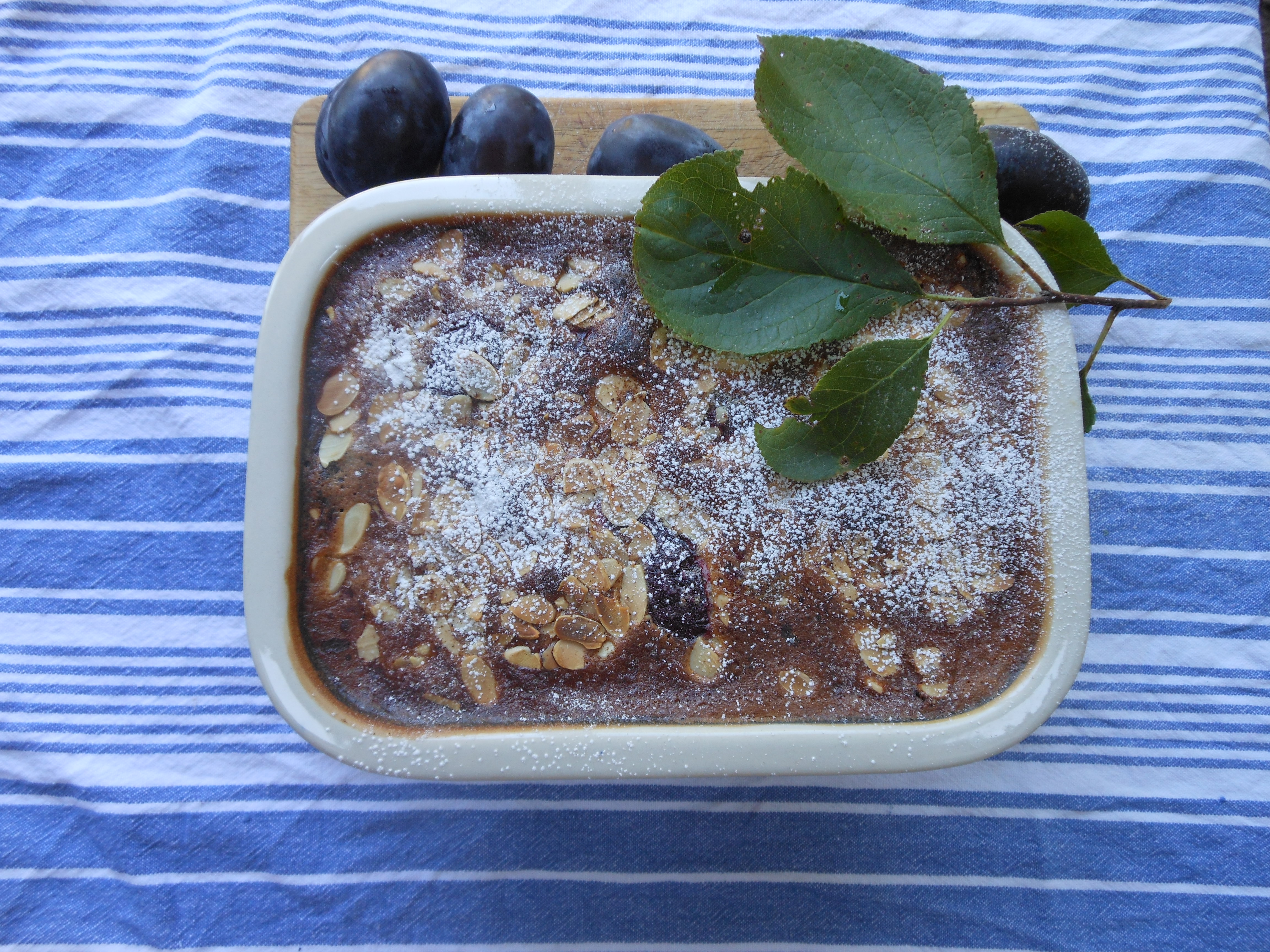
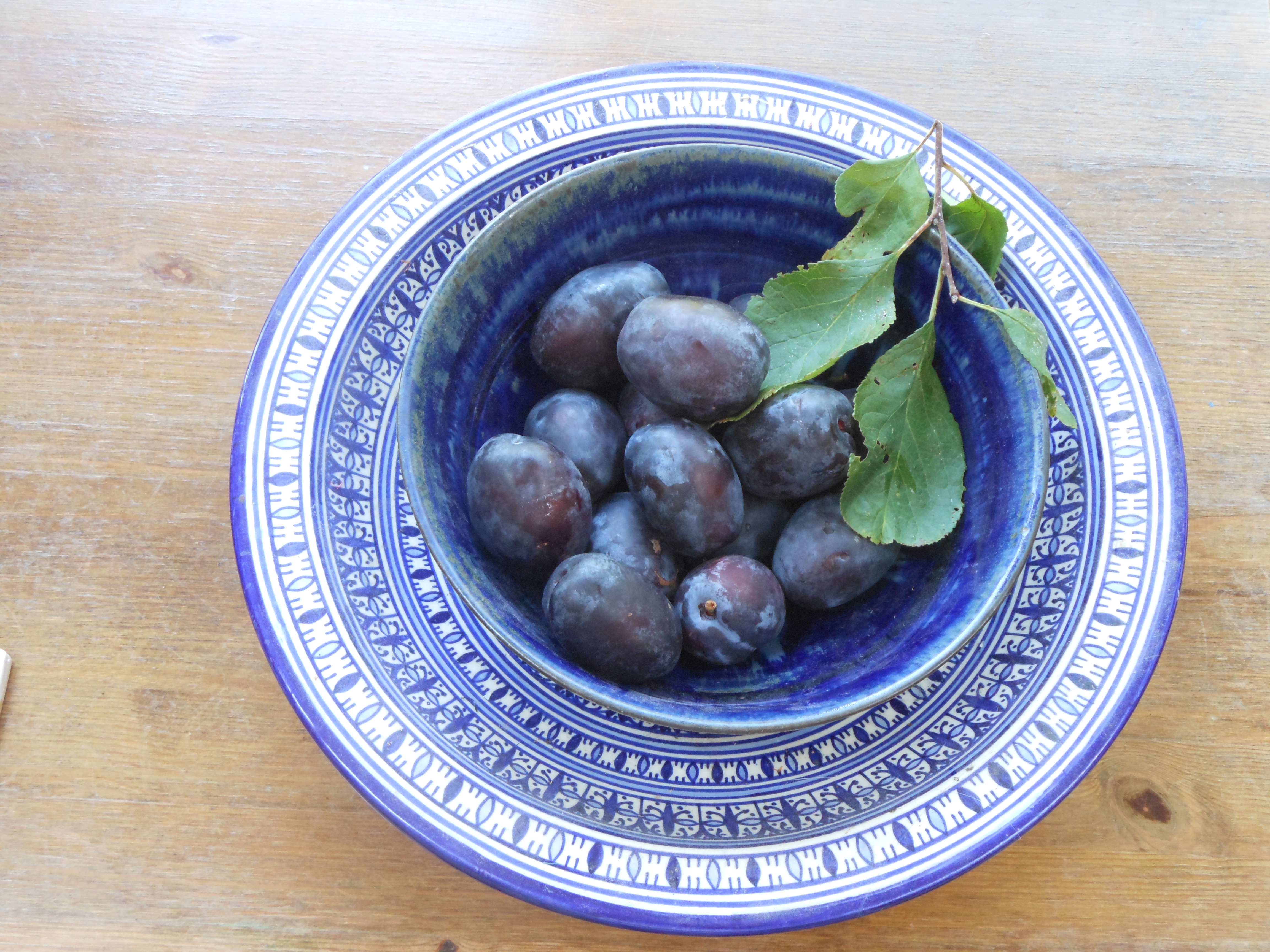
|
SEPTEMBER 2013
Plum Clafoutis
This is my version of the traditional combination of plums and custard. I find it a good way of using up gluts of plums in September. This year my plum tree produced plenty of fruit after being barren last year and despite this year’s cold spring. The French use their cherries with custard to make Clafoutis, often using cream and vanilla in their recipes, but this pudding is not as rich and is more of an everyday treat.
Basis of the dish:
500g (10oz) stoned and halved plums
25g (1 oz) butter
2 tablespoon of Demerara sugar
- Place the butter on the bottom of an ovenproof baking dish and bake in a hot oven until the butter foams.
- Remove dish and arrange the plums at the bottom of the dish and scatter the Demerara sugar over them. Return dish to oven and bake at 200C (425F; Gas 6) for a further 5 minutes then remove from oven and set aside.
Making the custard:
3 eggs
100g (4 oz) caster sugar
300 ml milk (10 fluid oz, ½ pint)
1 tablespoon plain flour
½ teaspoon of nutmeg
25g (1 oz) flaked almonds
Icing sugar
- Separate the yolks from the whites of the eggs
- Put the egg yolks with the sugar in a heatproof bowl and beat together. Place the bowl over a saucepan half filled with water and beat the mixture until it thickens.
- Remove bowl from heat then beat the milk and flour into the egg yolks. Set aside.
Combining the elements:
- In another bowl whisk the egg whites until stiff and glossy then fold into the yolk mixture.
- Spoon this mixture over the plums in the ovenproof dish and scatter with nutmeg and flaked almonds
- Place dish in an oven dish ½ filled with water and cover over the top loosely with foil to prevent the surface from over-browning. Bake at 180C (350F; Gas 4) for 1 hour or until the surface is springy but the plum custard below is of a looser creamier consistency. Check the custard is not too runny though as how juicy the plums you use makes a difference. You can experiment with this basic recipe trying it out with autumn fruits such as damsons and blueberries. These may need to be simmered in a saucepan separately beforehand depending on how firm they are.
|

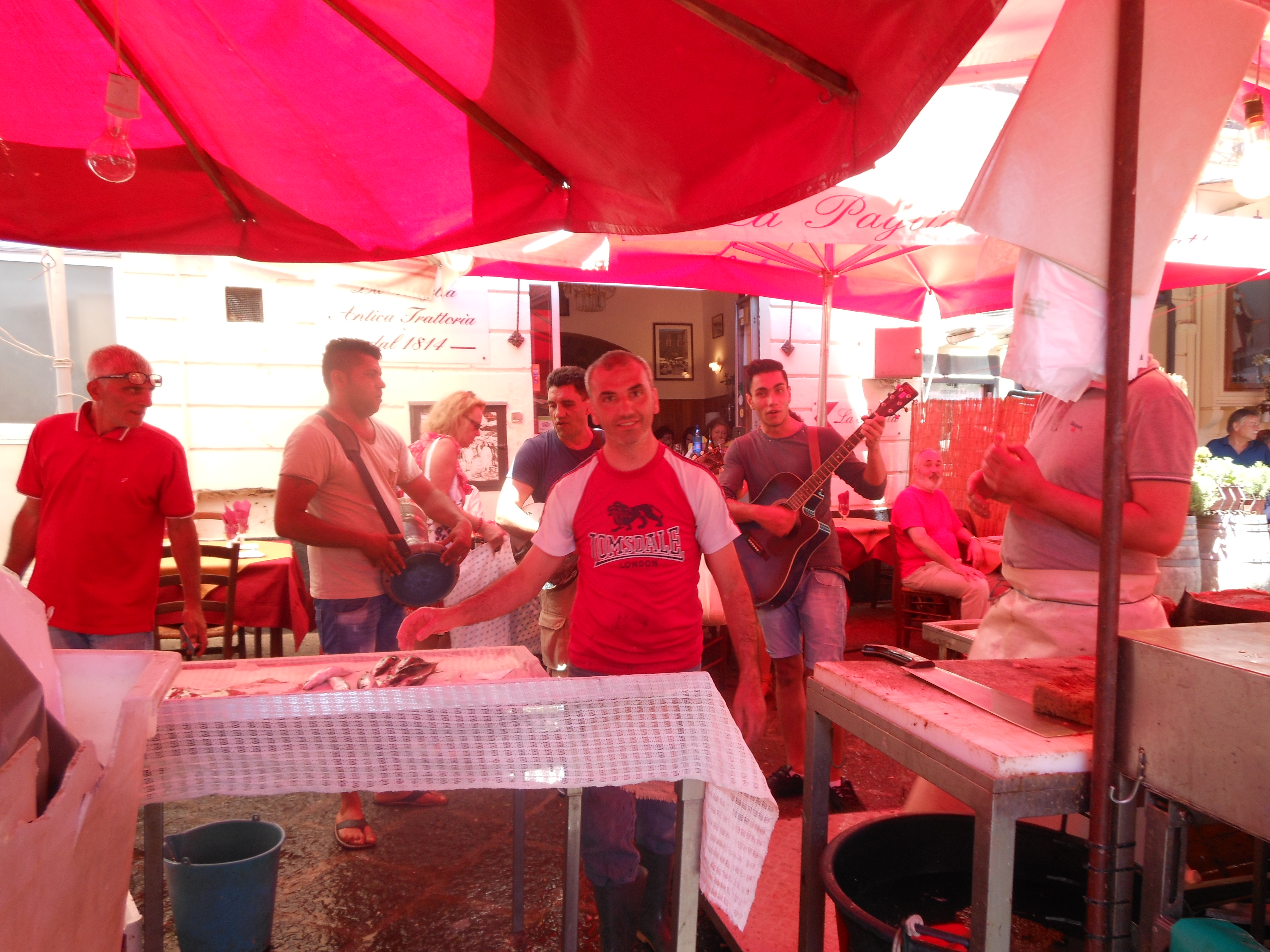
|
AUGUST 2013
SCICILIAN LEMON GRANITA
On holiday in Sicily this summer we visited the Pescharia, the famous food and fish market in Catania where we were served the most amazing granita al limone. These ices are like sherbet, with a sorbet-like granular texture and were wonderfully refreshing in the heat served topped with a scattering of alpine strawberries. The origins of this recipe can be found in the cuisine developed from the Arabic occupation of the island and are said to have been first made from the snow that lay on the peaks of Mount Etna and the Nebrodi mountains.
When we came back the hottest weather for seven years finally arrived in the UK and so I developed this version to try at home. The recipe couldn’t be simpler as it just consists of freshly squeezed lemon juice, water and sugar.
10oz (275g) granulated sugar
20 fluid oz (one pint) 600ml water
10 fluid oz (1/2 pint) 300 ml lemon juice from freshly squeezed lemons. If some are slightly green that is all to the good
A handful of Alpine strawberries to decorate. I picked mine from the garden!
- Bring sugar to the boil in a pan and simmer on a low heat for 5 minutes until dissolved.
Remove from heat, leave to cool then stir in the lemon juice and set aside in the fridge until completely cool.
- Pour mixture into a freezer proof container - I use a 1 litre empty ice cream container which these quantities just fill– and place in the freezer for 2 hours or just over. After 1 hour take container out and stir the contents every 20 minutes then return to freezer. The mixture will start to crystallize and go slushy. When the texture is granular serve at once. You can return any uneaten granita to the container and thaw out a little before serving again.
|
 |
JULY 2013
ROSY STRAWBERRY CREAM
This time of year is perfect for strawberries, and because of the late spring the crop is sweeter and the berries larger as they’ve had longer to develop, say the growers. At last my beautiful roses are out as well, so I thought I’d combine them in an easy recipe you can eat during Wimbledon. Based on Eton Mess, the rosewater and edible petals make it a little bit different.
8 meringue nests (4oz; 100g)
300ml (10 fluid oz) whipping cream
2 tablespoons of essence of Rose Water
400g (14oz) fresh strawberries
Rose petals from 1 large rose
- Pull the meringue nests apart with your hands and reserve.
- In a large mixing bowl whisk up the cream until it is stiff, then slowly incorporate 2 tablespoons of the rosewater essence into the cream.
- Hull, halve and wash the strawberries. Reserve a few to decorate the cream then add the rest of the berries into the cream mixture.
- Fold in the meringue pieces to the strawberry cream mixture.
- Spoon the strawberry cream and meringue mixture into a large glass bowl. This recipe makes enough for 8 servings so the bowl needs to be a reasonable size.
- Pull the petals from a large rose. Make sure no insects are lurking in the interior! Then scatter the petals over the top of the cream mixture and finally finish with a few of the halved berries. Don’t worry about the rose petals, they are perfectly OK to eat.
|
 |
JUNE 13
DERBY CHEESE & SAGE SUMMER PASTY
This is an easy-to-prepare summer recipe which uses the first wonderful spring greens of the season. I used my own mint and sage in this dish but used frozen Petit Pois as the season is too early for my own home grown peas. Creamy Derby and sage cheese is a locally produced delicacy.
For the vegetable accompaniments: Prepare these first
6 oz (150g) baby new potatoes
1 oz (25g) butter
A handful of fresh mint
2 oz (50g) Petit Pois
- Boil the potatoes in a saucepan of water and leave aside. Just before serving with the pasty, add the peas, simmer for 4 minutes and leave on the hob
For the pasty:
1 x (18oz) 500g (block of frozen uncooked puff pastry) or use puff pastry Light puff sheets ready rolled
1 tablespoon olive oil
4 spring onions, with the green top removed and set aside and the white stem chopped into ¼” (30cm) pieces
6 oz (150g) Chestnut mushrooms, wiped and sliced
3 oz (75g) fresh baby spinach leaves or a mixture of spinach, watercress and rocket leaves
4oz ((100g) Derby & sage cheese, grated
Sprigs of fresh sage to garnish
- Thaw the pastry out at room temperature for approximately 2 ½ - 3 hours.
- Lightly flour a marble work surface and also flour the pastry block before rolling out to the required thickness of ¼ (30cm)“. The pastry rectangle should be 12” (450cm) x 8”(200cm). Allow to stand on the work surface for a few minutes to reduce shrinkage.
- Meanwhile in a frying pan sauté the chopped white pieces of onion and the slices of mushroom in the olive oil until golden. Allow to cool.
- Oil a rectangular baking dish slightly larger than the pastry rectangle. With a fish slice, gently lift the pastry onto the oiled baking dish so they fit neatly into each other.
- Spoon the onion and mushrooms over the pastry, then spoon the raw spinach leaves on top of the cooked vegetables.
- Scatter the sage grated cheese on top of all these vegetables and cook in the top shelf of a hot oven for 25 minutes at 200C (400F; Gas 6).
Bring the pasty out of the oven when golden and well risen and scatter the fresh sage leaves on top of the melting cheese. Serve on warm dinner plates with the drained potatoes and peas with added butter then scatter the potatoes with fresh mint. |
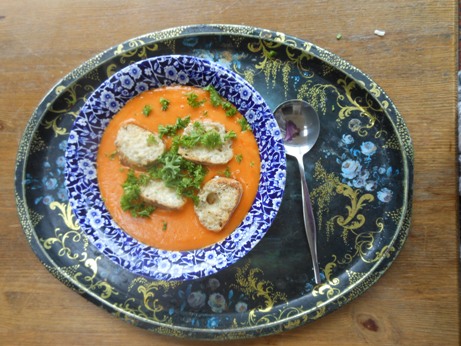 |
MAY 13
This is a very tasty, nourishing soup which includes more than the five-a-day vegetable quota and lentils for protein. I like to make this soup to aid recovery after illness.
Ingredients
1 onion
4 cloves of garlic
2 sticks of celery
1 red pepper
2 potatoes
2 carrots
1 tablespoon of fresh parsley
7 oz (200g) tin of plum tomatoes (optional: without them the soup is orange in colour and with them it is more of a red colour. Sometimes I replace the plum tomatoes with chopped sundried tomatoes for a more intense flavour)
4oz (100 g) red lentils
Olive oil
1 pint of chicken stock from a chicken carcass + 1 vegetable stock cube
(Or for vegetarians, 1 vegetable stock cube dissolved in 1 pint of water)
4 slices wholemeal bread, toasted
4 oz (100g) grated cheese
-
Roughly chop the onion and garlic. Pour enough olive oil to cover the base of a heavy-bottomed saucepan (I use a large preserving pan) and stirring gently fry the onions and garlic until golden.
-
Roughly chop up all the fresh vegetables then reserve the parsley. Place all the chopped vegetables and the lentils over the cooked onions and garlic, pour the stock over them and simmer slowly over a low heat until soft, stirring from time to time to prevent the soup sticking to base of the pan. At this stage, pour in the tin of tomatoes and their juice if you are using them.
-
Allow to cool, then liquidize in a blender or sieve over a large bowl until smooth. Transfer the soup back to the pan and add extra water to taste if the mixture seems too thick. Heat through, stirring all the time.
-
Toast the bread and scatter grated cheese over each slice, then toast under the grill. Cut into small pieces then pour soup into bowls and float the cheesy croutons onto the soup, then scatter with the fresh parsley and a little salt and pepper to taste.
Serves 4 |
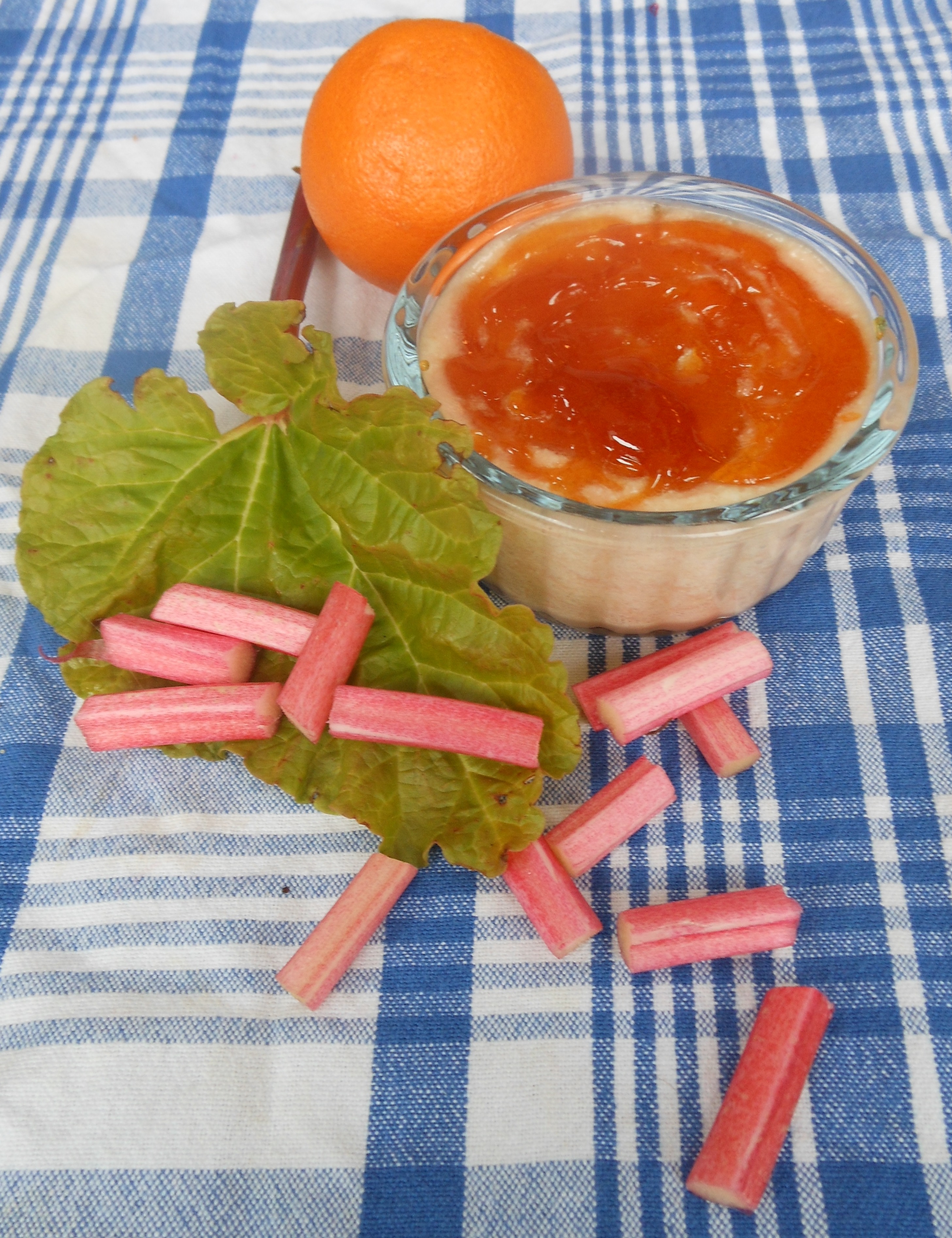 |
APRIL 2013
RHUBARB & ORANGE CREME BRULEE
Here in the North of England rhubarb is still grown commercially under cloches in the Yorkshire Triangle for early forcing and it’s a very welcome fresh ingredient at this time of the year. I grow the variety Champagne in my own garden in Cheshire; it has a wonderfully sparkling taste and blends in well with spices such as ginger. In this recipe I partnered it with orange, a combination I usually use in crumbles but I thought the toffee flavour of a burnt sugar topping would be a good contrast to the creamy fruit mixture.
1lb (450g) sticks of rhubarb
3 oranges
1 dessertspoonful of freshly grated orange zest from 1 of the oranges
2 ½ oz (75g) Demerara sugar
6 fl oz (175ml) freshly squeezed orange juice from the oranges
6 fl oz (175ml) double cream
1 egg
- Wash and cut the rhubarb into small pieces, then put them into a saucepan with the sugar, orange zest and orange juice. Gently simmer over a low heat and stir until the mixture has become a puree. Cool and then put into a fridge to chill.
- In a bowl, whip the double cream until stiff and forming peaks
- Separate the egg white from the yolk and pour the egg white into a bowl and whip until stiff and forming peaks. (Reserve the egg yolk to glaze scones later).
- When the rhubarb mixture is very cold, beat the whipped cream into the puree and then fold in the whipped egg white. Pour this into individual ramekin dishes, cover and leave in fridge until set. (2 hours).
- To make the brulee topping: Make this one hour before serving, to allow the rhubarb and orange cream to cool. Place 3 oz (75g) granulated white sugar in a heavy bottomed saucepan and warm through on a very low heat. Don’t stir, but shake the sugar in the pan from side to side to stop it sticking. It takes about 15 minutes to turn into a clear golden syrup. When all the granules have dissolved take the ramekins out of the fridge and with a dessertspoon spoon the syrup over the top of each ramekin. Allow to harden in the fridge for one hour and then serve.
- This recipe fills 3 medium sized ramekins, so double the quantities if you need to make more.
|

|
MARCH 2013
DEVILLED CHICKEN
This is a recipe my youngest daughter asked me for recently as she remembered it as one of her favourites when she was growing up. It’s a rich dish, although somehow lighter than a curry but very warming and ideal after a walk in the wild March winds.
Devilled Sauce
8 oz (225 g) cooked chicken pieces
11 fl ounces (300 ml) single cream (or plain Greek yoghurt or crème fraiche if you prefer)
2 tablespoons Korma curry paste
1 teaspoon Dijon mustard
2 teaspoons whole grain English mustard
Pour the cream/yogurt/crème fraiche into a bowl and add the Korma paste, the mustards and mix well.
Immerse the chicken pieces and leave to marinate for a couple of hours.
Rice Pilaff to accompany the Devilled Chicken
6oz brown rice
1 onion (chopped)
½ red pepper (chopped)
1 x 3” (8cm) carrot (finely chopped)
1 tablespoon of olive oil
2oz (50g) blanched almonds
1 oz (25g) raisins
1 tablespoon finely chopped parsley or coriander leaves
A few sprigs of watercress
- Cook the brown rice in water in a saucepan until soft, then rinse, drain and leave aside
- In a frying pan, pour the olive oil and add the chopped onion, red pepper, and carrots. Sauté until the vegetables are soft
- Add the blanched almonds to the vegetables and sauté until the almonds are brown.
- Add the raisins and take off the heat.
In a saucepan add the chicken and the sauce and heat gently until the chicken is warmed through. Meanwhile heat the rice pilaff in the frying pan and then scatter the parsley leaves over the mixture. Serve the pilaff with the Devilled Chicken and peppery watercress on the side.
Serves 4 |
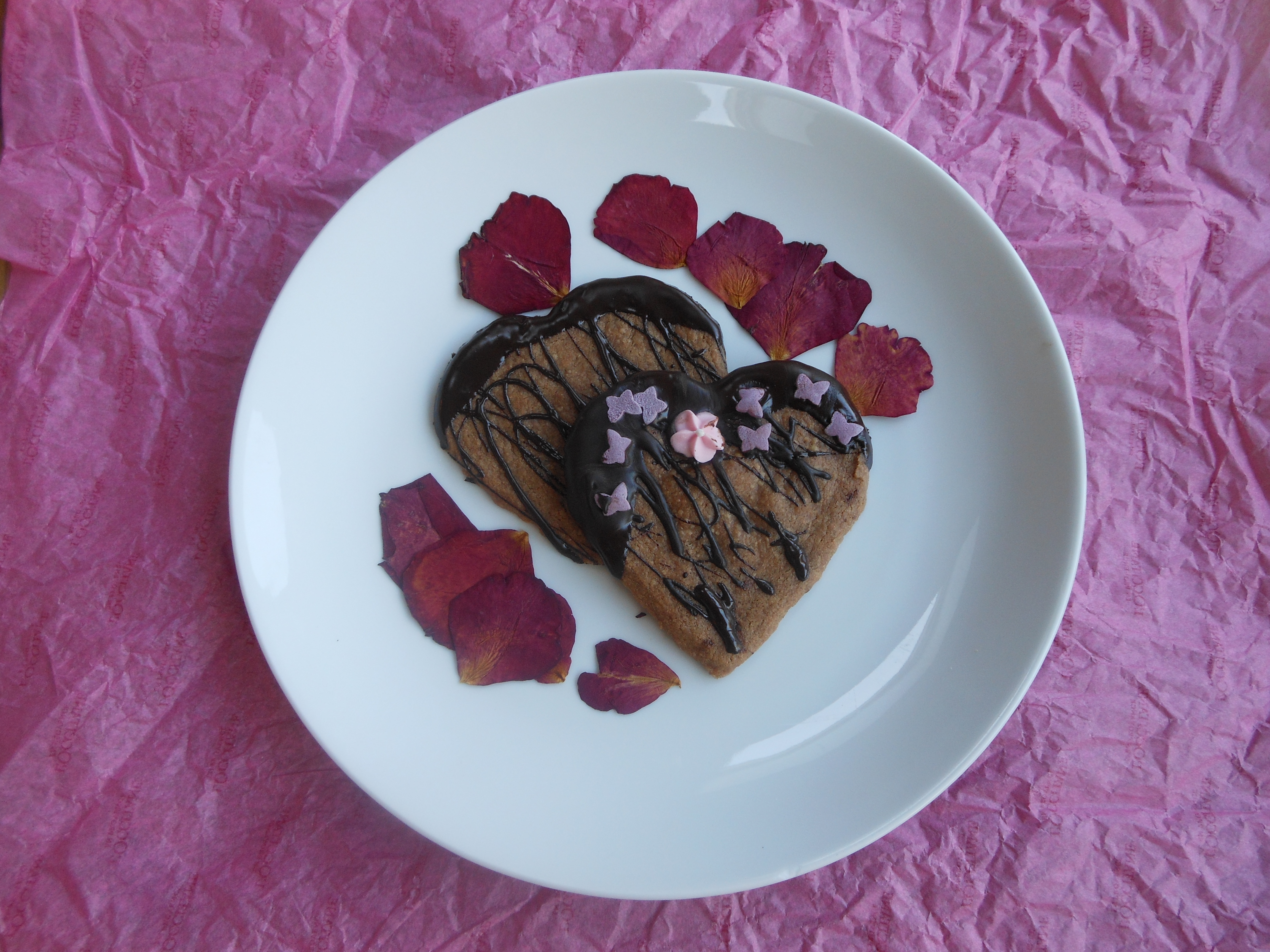
|
FEBRUARY 2013
CHOCOLATE VALENTINE HEART S
‘Rose are red, violets are blue, sugar’s sweet and so are you.’
Using classic shortbread biscuit ingredients, this recipe is easy to make and individualise and you can serve them to accompany your home-made Valentine card.
4 oz (110g) butter at room temperature
2 oz (50g) caster sugar
6 oz (175g) plain flour
1 teaspoonful of cocoa powder
Chocolate Icing: (4 oz) (110g) 70% dark cooking chocolate (I used Lindt)
A handful of decorative flowers: crystallized violets or sugar roses. Rose petals to scatter.
Pre-heat oven to Gas mark 2, 150C.
- In a mixing bowl beat the butter to a soft consistency with a wooden spoon, then beat in the sugar.
- Sift the flour and cocoa over this mixture, then using the wooden spoon mix in the flour and cocoa to form a lump then finally with your hands quickly form this into a paste that you can easily roll out. To not allow it to get too warm though.
- Lightly dust a marble pastry slab with caster sugar then transfer the biscuit paste onto the slab and roll out with a sugar-dusted rolling pin to a thickness of 1/8” (3mm).
- Using a heart-shaped 4” (10cm) long and 3 ½ “ (9cm) wide pastry cutter cut out 10 heart shapes then with a fish slice carefully transfer them onto a lightly greased baking sheet.
- Bake in the highest shelf of the oven for 30 minutes.
- When ready, leave to cool for 5 minutes then using the fish slice transfer onto a wire rack until completely cool
- Meanwhile, break up the cooking chocolate into small pieces and melt in a heat-proof bowl over a saucepan of hot water until liquid.
- When the biscuits are cool, holding them by the pointy end, dip the heart shaped end into the liquid chocolate and drizzle a little chocolate onto the surface of the heart. Before the chocolate sets, decorate with the sugar flowers as you like. Or you could press some rose petals into the chocolate (they are edible) or use them to scatter over the plate you are serving them on to decorate.
|
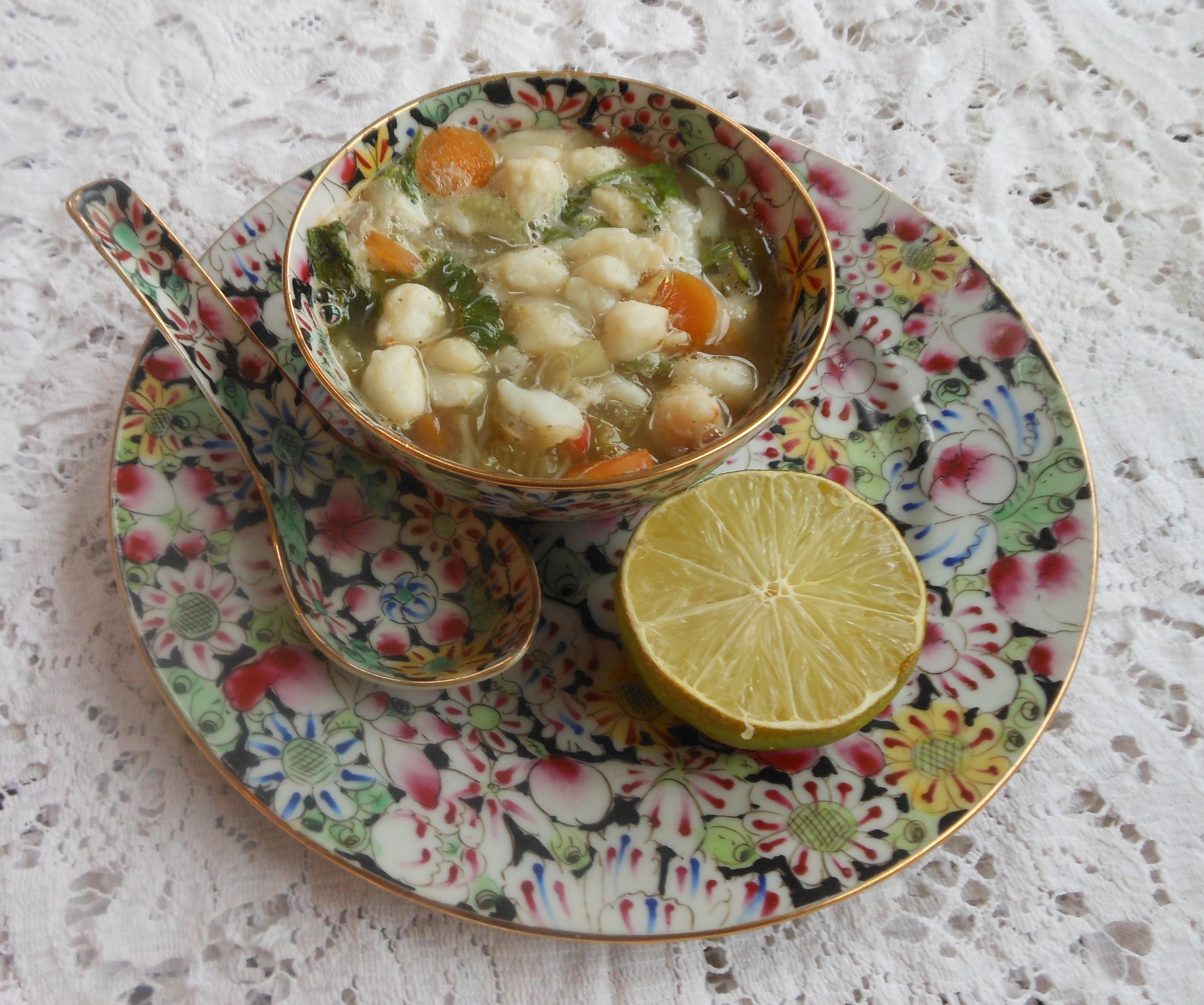
|
JANUARY 2013
SLIMMING ORIENTAL CRAB & NOODLE SOUP
I developed this recipe because it uses very healthy low-calorie ingredients and because so many of us are trying to cut down on food after the party season. Nevertheless it’s surprisingly filling and only takes 10 minutes to prepare and 10 minutes to cook.
It’s inspired by Thai and Vietnamese cuisine but you should be able to obtain everything from your local supermarket.
2oz (50g) vermicelli rice noodles
1 vegetable stock cube
1 teaspoon of anchovy paste
2 spring onions, chopped finely and with the green tops chopped and reserved for garnish
1 x 3” long carrot chopped into small circles
1 stick of celery finely chopped
½ red chilli, de-seeded and chopped
1 teaspoon of finely chopped fresh ginger
7 ¼ oz (200g) crab pieces, tinned or fresh. The Cornwall based www.seafoodand eat it.co.uk supplies wonderfully British fresh refrigerated crab even if you live far from the sea as I do
Freshly squeezed juice of half a lime
A handful of chopped fresh coriander
A handful of chopped fresh mint
- Drop noodles into a deep pan of boiling water and cook for 2 – 3 minutes. Drain and rinse under cold water then immerse in a bowl of cold water until needed
- Dissolve 1 vegetable stock cube in 1 pint of boiling water in a deep saucepan. Stir well then add the anchovy paste and stir until dissolved
- Put the chopped onions, carrot, celery, chilli and ginger into the stock and simmer for 5 minutes
- Turn down the heat and add the crab meat, lime juice, coriander leaves and mint
- Add the noodles and stir. Leave for 1 minute then serve steaming hot in soup bowls, garnish with the chopped green tops from the spring onions
|

|
DECEMBER 2012
TURKEY SPELTOTTO
Here’s a spicy risotto recipe I’ve developed to use up turkey leftovers and other items you might have in the fridge or store cupboard. It takes just twenty minutes to make and features a product I’ve only recently discovered which has now become a permanent stand-by in my kitchen. This is Sundried Tomato & Chilli Speltotto which uses spelt, a nutritious wheat species now enjoying a revival for its health-giving properties.
Spelt has been around since the Bronze Age and because it requires fewer fertilizers to grow and offers a broader spectrum of nutrients than other wheat grains it has become popular with organic farmers. It‘s an excellent source of manganese, niacin, copper, phosphorus and fibre and helps with the prevention of heart and circulatory diseases, gallstones, cancer and childhood asthma. It clearly has robust properties, as anecdotal reports say that after the nuclear accident at Chernobyl the only grain still growing in the vicinity was spelt. You can buy pure pearled spelt for other risottos but I find this Sundried Tomato & Chilli version really useful. Have a look at www.sharphampark.com to find out more about spelt products.
1 onion, peeled and roughly chopped
2 cloves of garlic, peeled and chopped
1 stick of celery, chopped into small segments
Half a red pepper, deseeded and chopped
4 chestnut mushrooms and a handful of dried porcini mushrooms
8 ¼ oz (225g) Sundried Tomato & Chilli spelt
9 oz (250g) cooked turkey pieces
1 pint chicken or turkey stock
4 tablespoons white wine
A handful of chopped fresh parsley or coriander
1 tablespoon of olive oil
A handful of Parmesan shavings
- Sauté the onion and garlic in the olive oil in a deep heavy bottomed frying pan until soft
- Add the celery, pepper and mushrooms stirring gently so they don’t stick
- Add the stock and Speltotto, stirring all the time and simmer for 10 minutes
- Add the turkey pieces, stirring all the times and simmer for another 5 minutes until all the liquid is absorbed and so reduced that you can stand a spoon upright in it. Add the wine at the last minute and garnish with the herbs and Parmesan shavings.
This dish serves 4
|
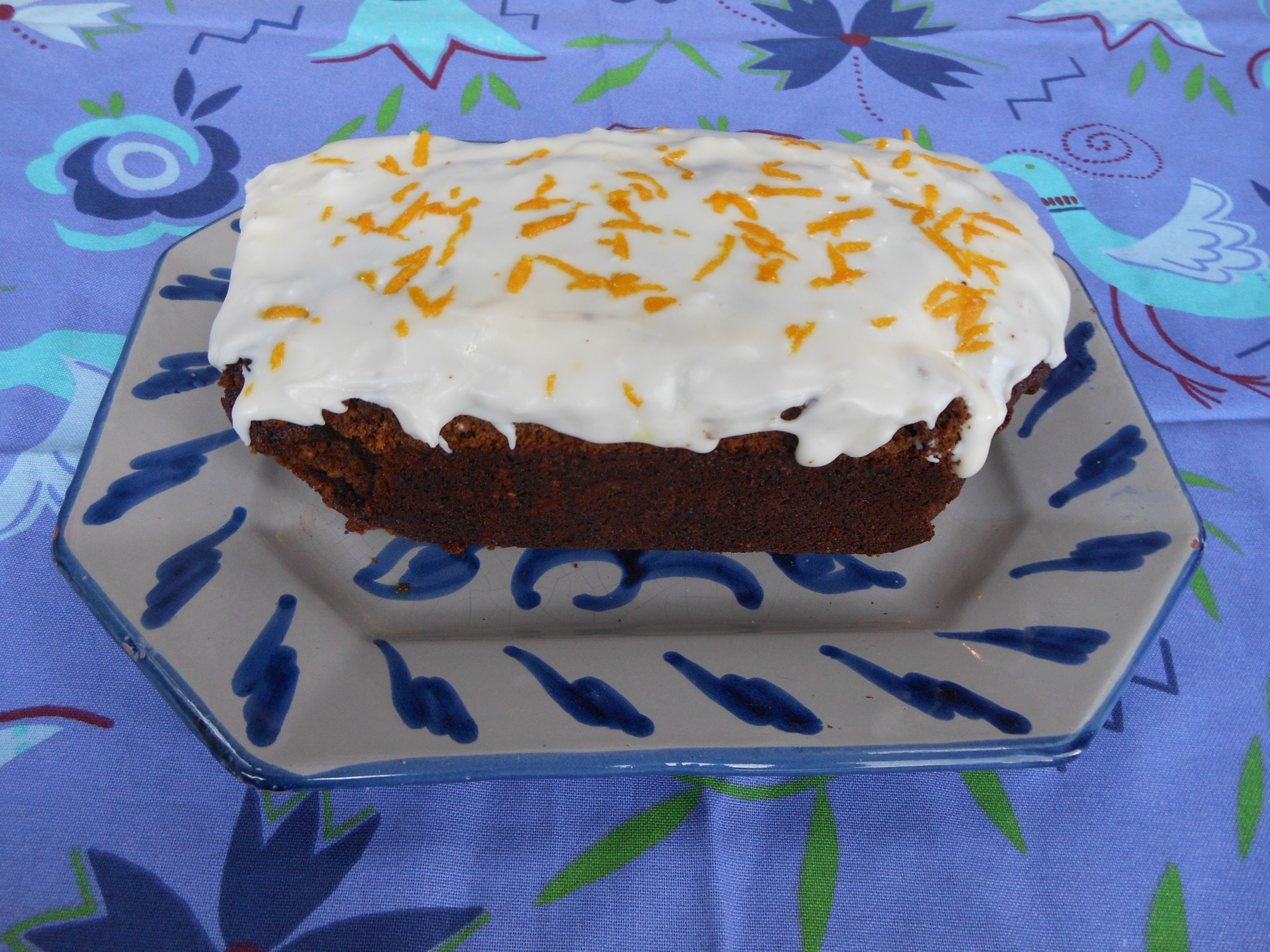
|
NOVEMBER 2012
ORANGE AND GINGER PARKIN
Spicy gingerbreads and parkins are warming treats at this time of year and oranges, clementines and satsumas are plentiful in the shops now to brighten dull days. I married the two flavours in this traditional parkin with an orangey twist.
For the cake:
4oz (125g) crystallised ginger
1 orange
8 fluid oz (200ml) fresh orange juice
4oz (125g) butter
3oz (75g) dark brown sugar
4oz (125g) dark treacle
3 eggs
8oz (225g) self-raising wholemeal flour
2oz (50g) rolled oats
5ml (1 teaspoon) bicarbonate of soda
10ml (2 teaspoons) of ground ginger
25g (1/2 teaspoon) of grated nutmeg
- Chop the crystallised ginger into small pieces and grate the zest from the orange. Soak the ginger in a bowl in 8 fluid oz (200ml) orange juice and add the orange zest. Leave in the fridge for a couple of hours.
- Make the cake: Put the butter, sugar and treacle in a saucepan, heat until butter has melted, stirring all the time. Leave to cool slightly.
- Beat in the eggs one at a time into the treacle mixture then set aside.
- Into a bowl sift the flour then add the soda, spices and oats. Stir well.
- Stir into this mixture the crystallised ginger/orange mixture then gradually stir in the treacle mixture.
- Line a 1kg (2lb) loaf tine with double thickness greased greaseproof paper. Spoon the cake mixture into the tin and bake in a preheated oven at 180c/350F/Gas 4 for 50 minutes – 1 hour (until a skewer poked into the centre comes out clean). Cool on a wire rack overnight.
For the orange icing topping:
Zest from a second orange and 8 teaspoons of fresh orange juice
4oz (125g) icing sugar
Grate the zest from the orange and set aside. Put the icing sugar into a bowl then gradually mix the orange juice into the sugar to form a smooth spreadable paste. Spread over the top of the cake and when set scatter the orange zest on top to decorate.
|
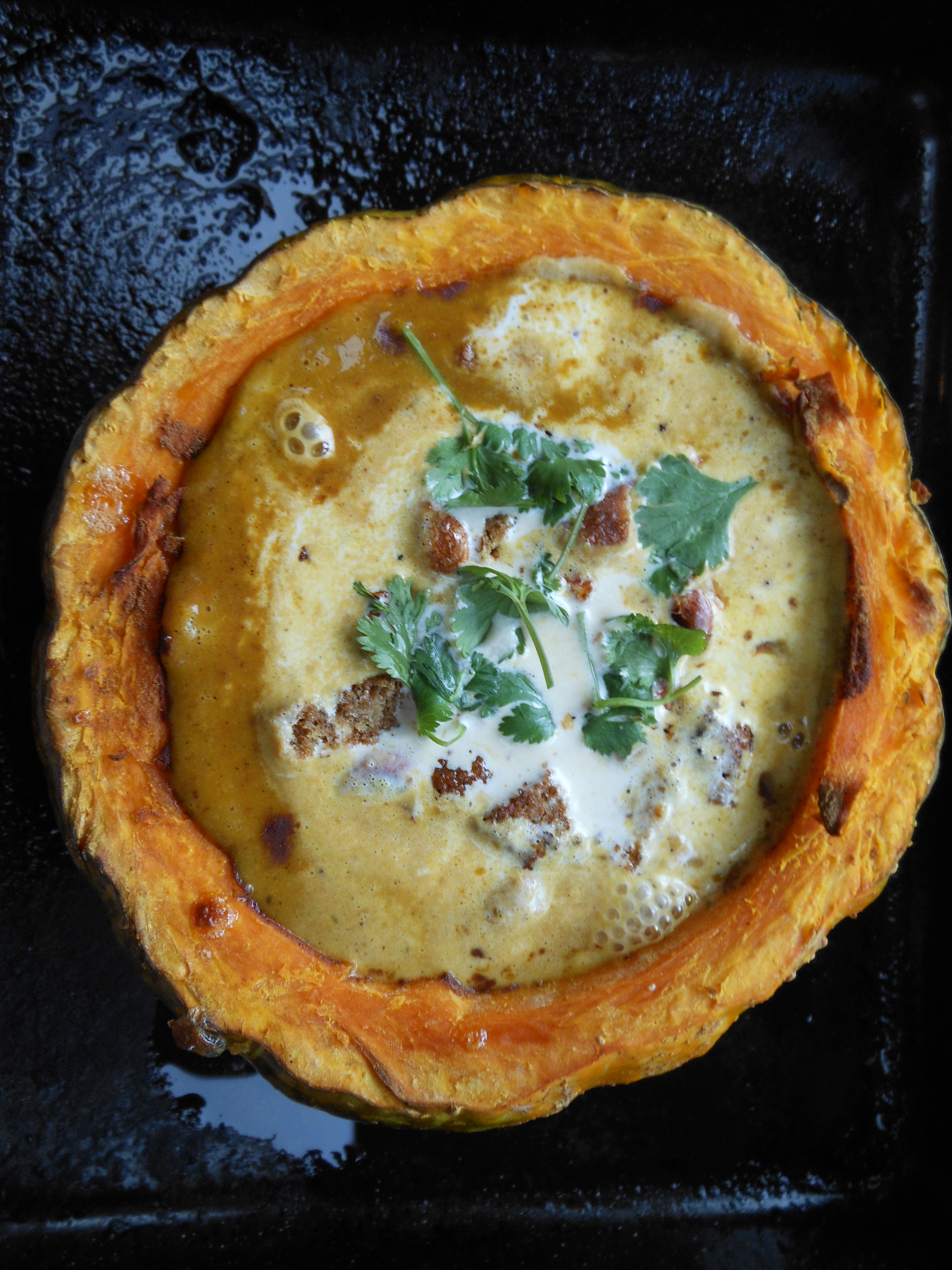
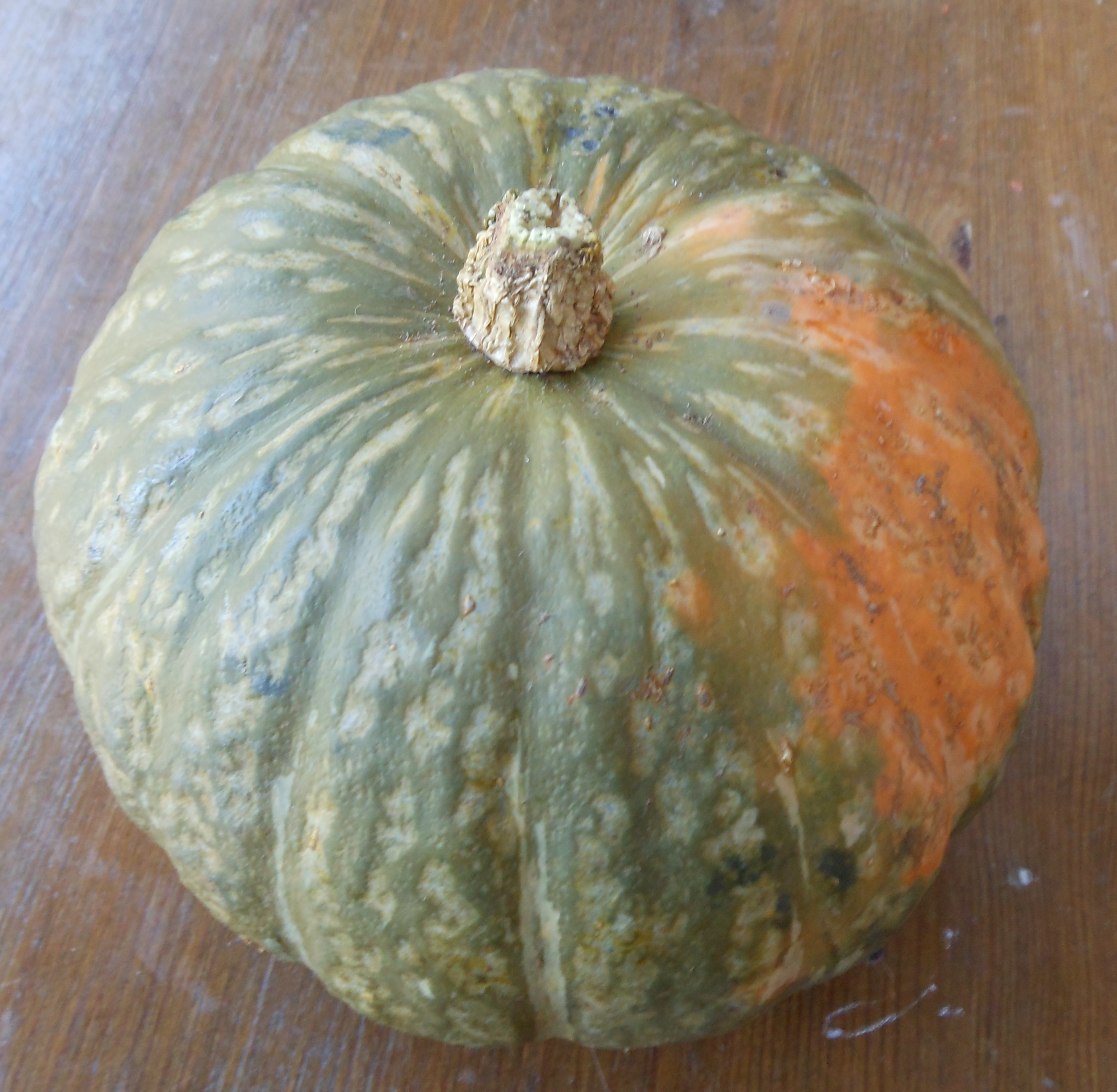
|
OCTOBER 2012
SQUASHED SQUASH SOUP
October’s the month for pumpkins, squashes and lumpy bumpy gourds. This spicy soup, baked in the oven in its own skin in with its top off is made from a Greek Kabocha squash as I didn’t grow any this year. Warming and satisfying, I served it with fresh oven-warmed bread croutons, chopped fresh coriander leaves and the sautéed seeds.
1 x 7 “(18cm) diameter squash
1 white onion
2 cloves garlic
3 tablespoons of olive oil
1 pint of hot chicken or vegetable stock
2 tablespoons of single cream
1 teaspoon of paprika
1 teaspoon ground nutmeg
1 teaspoon ground coriander
1 teaspoon cinnamon
Sprig of fresh chopped coriander
Salt & black pepper
A slice of left-over brown bread for croutons
- Slice the top from the squash with a sharp bread knife. (Take care it doesn’t slip). Scoop out the seeds, flesh and fibrous material and set aside. Chop the flesh into small pieces then place squash shell onto a lightly oiled deep-sided roasting dish.
- Roughly chop the onion and garlic and sauté in a large heavy-bottomed saucepan in a tablespoon of olive oil until golden.
- Add the stock, chopped pieces of squash, paprika, nutmeg, ground coriander and cinnamon to the pan and simmer for 10 minutes. Allow to cool then blend in a blender until smooth. Preheat the oven.
- Pour the soup into the hollowed out squash shell and put into the oven to bake for 40 minutes at 190c (170c if a fan oven) or Gas 5.
- While the soup is cooking, separate the seeds from the fibrous material and in a frying pan sauté a handful of them until golden in 2 tablespoons of olive oil and with the bread chopped up into squares, stirring all the time so they don’t burn. Season with salt and set aside.
- After the soup has been baking for 40 minutes, remove it from the oven and pour the cream into the shell. Stir and put back into the oven for another 10 minutes until the soup is hot and adjust the seasoning. Transfer the croutons and seeds to the oven in a little oven proof dish to warm through while the soup is finishing.
- It looks really pretty in its shell! Serve with the croutons, seeds and a handful of fresh coriander. Ladle out into individual bowls. (Serves 3).
|
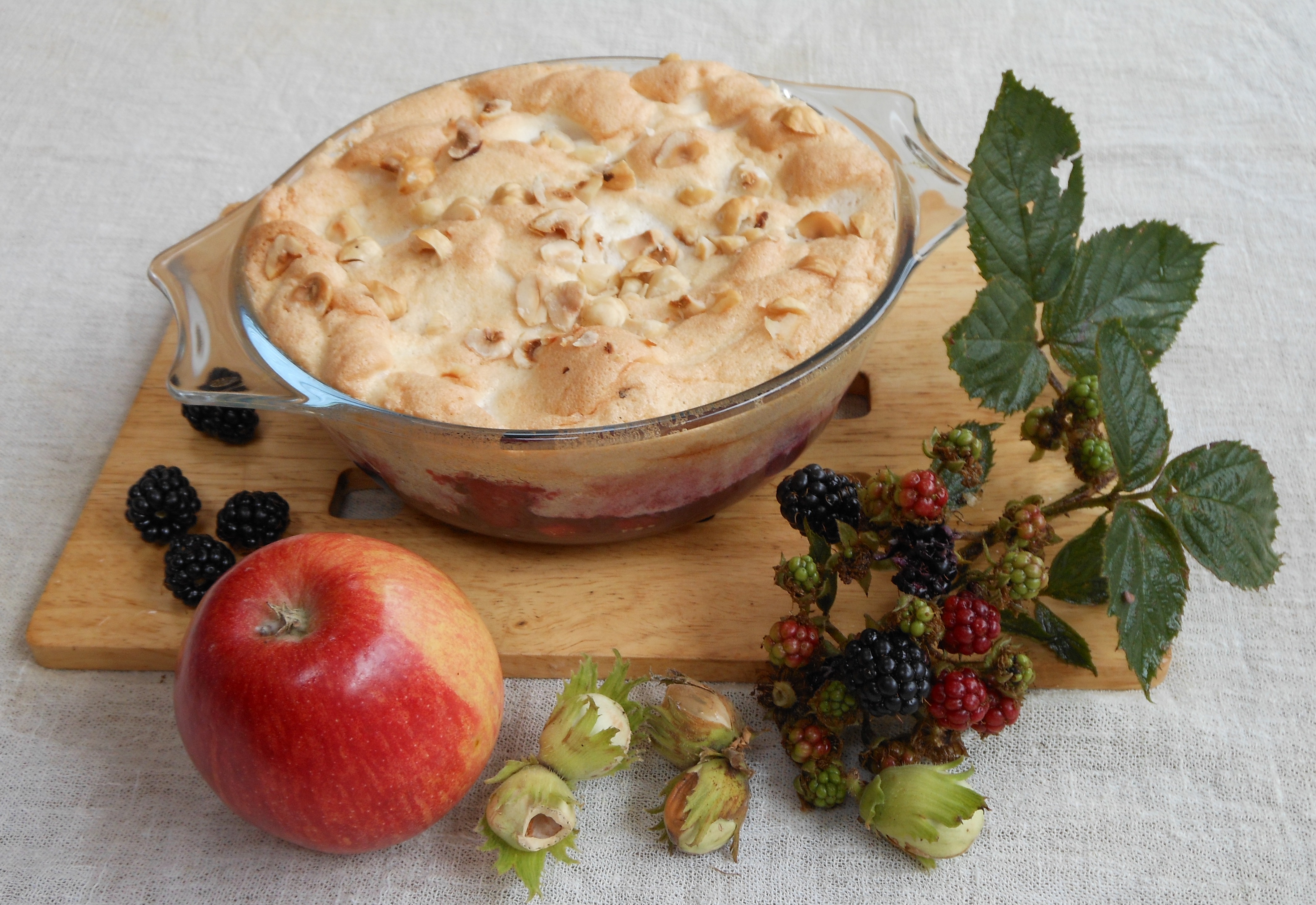 |
SEPTEMBER 2012
WINE-POACHED BLACKBERRY AND APPLES WITH HAZELNUT MERINGUE
I created this recipe to use the hedgerow blackberries I gathered along the canal banks and to make the most of the apples from the Newton Wonder tree in my garden. The hazelnuts were supposed to come from my own trees too, but this year as usual the squirrels beat me to it.
For the fruit compote:
7 ¼ oz (200g) blackberries
2 apples 5 ½ (150g) peeled and cored weight
1 oz (25g) Demerara sugar
2 tablespoons of full-bodied red wine
Wash the blackberries, and if necessary soak in salt water for an hour first to remove any worms! Peel and core the apples then slice into small pieces. Place in a saucepan, add the wine and sugar and gently simmer on top of the stove until the apples are soft and have turned ruby red. (10 minutes). Remove from pan and pour into a 7” (18cm) diameter ovenproof dish.
For the hazelnut meringue:
3oz (75g) shelled hazelnuts
2 egg whites (use the yolks to glaze pastry or scones)
3oz (75g) caster sugar
Grind 2oz (50g) hazelnuts in a blender or mortar and pestle until they resemble powder. Roughly chop up the remaining 1oz (25g) of hazel nuts and reserve. Whisk the egg whites until frothy then gradually add the sugar until the mixture is stiff and glossy. Then fold in the powdered hazelnuts and spoon the mixture over the fruit in the ovenproof dish, fork it up into little peaks then scatter the chopped hazelnuts over the top. Bake in the middle shelf of an 180C, Gas mark 4, oven for about 15 minutes until meringue is golden brown and crisp. Serve hot or cold with vanilla ice cream.
|
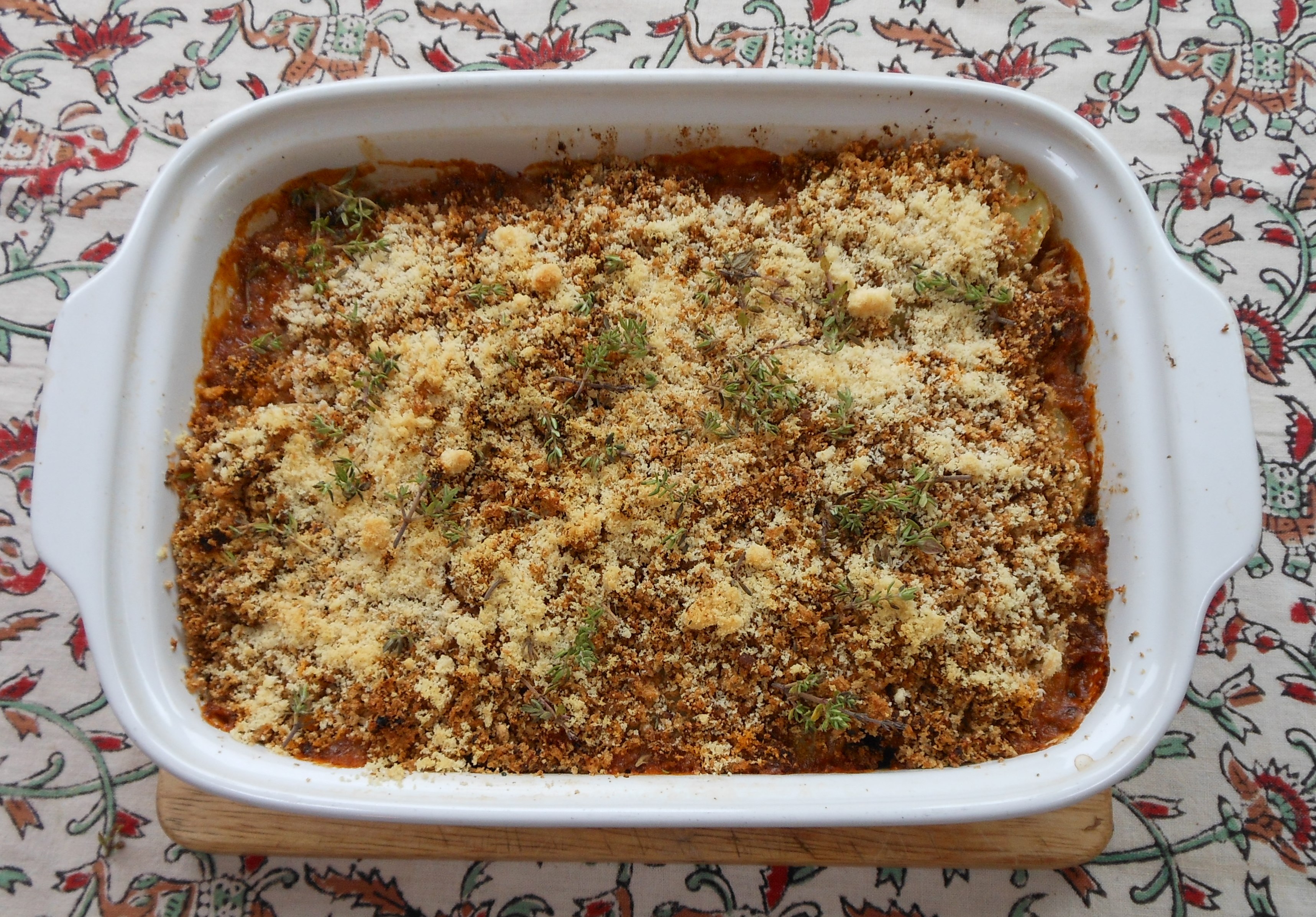 |
AUGUST 2012
Tomato and Courgette Bake
This fresh-tasting recipe is a good way to use up gluts of tomatoes, courgettes and potatoes that August often produces. It’s a hearty rustic dish which allotment holders may find useful. (6 big portions).
1 ½ lbs (750g) courgettes (about 3 large courgettes about 8” (20cm) long)
2 cloves of garlic, crushed
1 medium sized onion, chopped
1 ½ lbs (750g) tomatoes, peeled and roughly chopped
4 oz (100g) chestnut mushrooms, sliced
1 oz (30g) butter
3 tablespoons (45ml) olive oil
8oz (200g) potatoes
4oz (100g) brown breadcrumbs
1 tablespoonful tomato pesto
4 tablespoonful powdered or grated Parmesan cheese
1 bunch fresh thyme + extra chopped to serve
1 teaspoonful sugar
Pinch of sea-salt & sprinkling of black pepper
- Method: Wash and thinly slice the courgettes, then sauté for 5 minutes in a large heavy based frying pan with 3 tablespoons of olive oil, turning over once so that each side is browned. Remove from pan and reserve on a plate.
- Put the chopped onion and garlic in the frying pan and gently sauté in the remaining oil until soft and golden, stirring from time to time so they don’t burn, then add the sliced mushrooms and sauté these for a minute or two with the onions and garlic mixture. Leave in the pan when cooked.
- While they are cooking, bring a large saucepan filled with water to the boil and simmer the tomatoes in it until they are soft enough for their skins to split easily. Remove them from the pan and when cool enough to handle, remove the skins and chop the tomatoes into quarters.
- Add the tomatoes to the frying pan with the onions and garlic and simmer together for 15 minutes, adding a teaspoon of sugar, salt and pepper and a large bunch of thyme (tied together by their stalks so you can remove it when the tomatoes are cooked). Stir in the courgettes, add the butter and simmer for another 15 minutes, then transfer to a large oven-proof dish.
- Meanwhile, par-boil the potatoes in the pan of water you boiled the tomatoes in and when they are partly cooked, slice thinly into scallop shapes. Arrange these over the courgette and tomato mixture so the vegetables are completely covered.
- Then put the breadcrumbs into another dish and spoon tomato pesto into them. Mix well together then spread evenly over the top of the potato layer. Finally sprinkle the cheese over the breadcrumb and pesto layer.
- Bake for 30 minutes in the centre shelf of a pre-warmed oven at 200C (400F, Gas 6). Scatter with chopped fresh thyme and serve with a green salad.
|
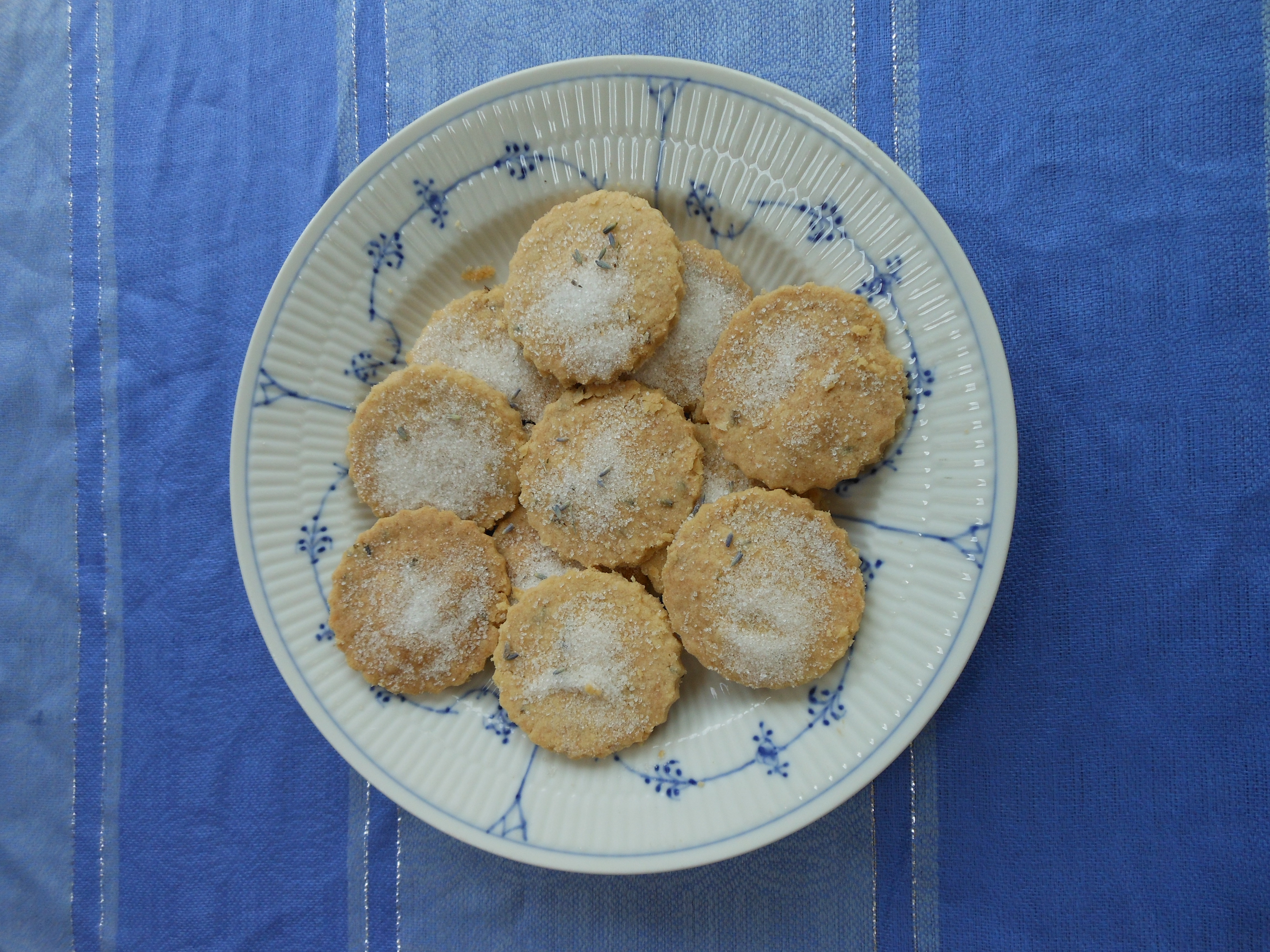 |
JULY 2012
Lavender Shortbread Biscuits
4oz (110g) butter at room temperature
2 oz (50g) lavender sugar shaken up before use; (available at good supermarkets but you can make your own by adding a handful (5g) of lavender flowers to 300g ordinary caster sugar and leaving in a closed screw top jar for a week to let the lavender flavours permeate the sugar. Leave the flowers in when ready to use)
6 oz (175g) sifted plain white flour
Extra lavender sugar for scattering
Pre-heat the oven to gas mark 2 (300 F (150 C)
Grease a baking sheet
Begin by beating the butter with a wooden spoon until it is of a soft consistency then beat in the lavender sugar complete with flowers. Add the sifted flour and with the wooden spoon bring the mixture together until it becomes like dough. Dust a board with lavender sugar and transfer the biscuit mixture onto it, lightly forming it with your hands until it is possible to roll it out with a rolling pin dusted with caster sugar to ¼” (6 mm) thick. Using a 2 ½” (6.5cm) fluted cutter cut out the biscuits. With a fish slice, carefully lift each biscuit up from the pastry board and transfer onto the greased baking sheet. Bake on the middle shelf of the oven for 30 minutes. Using the fish slice, transfer the biscuits onto a wire rack. Scatter with more of the lavender sugar and leave to cool. Store any uneaten biscuits in an airtight tin to keep them crisp.
Makes about 12 |
|
|